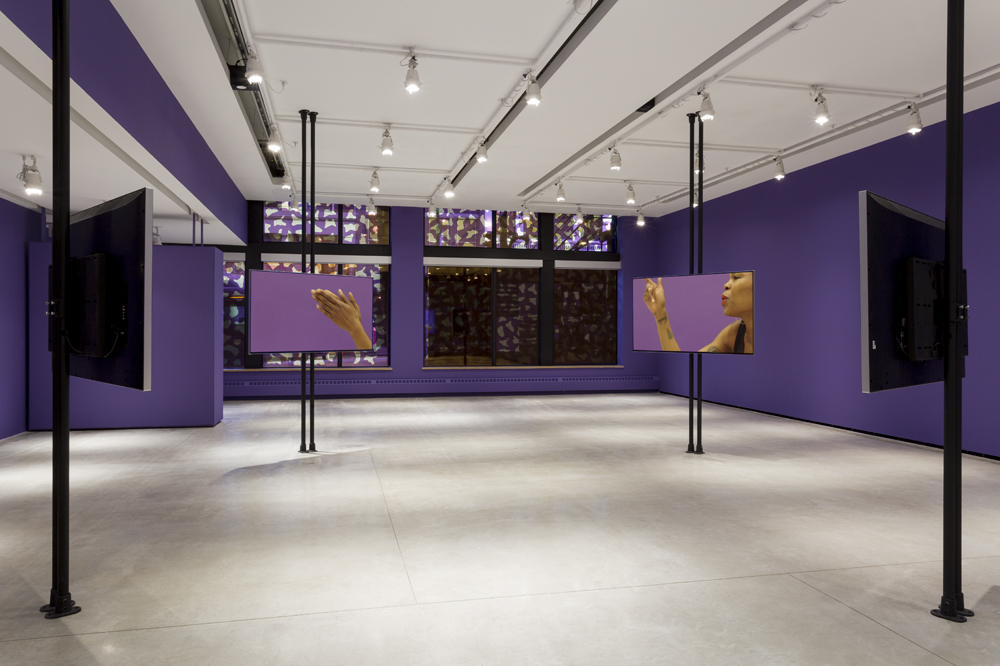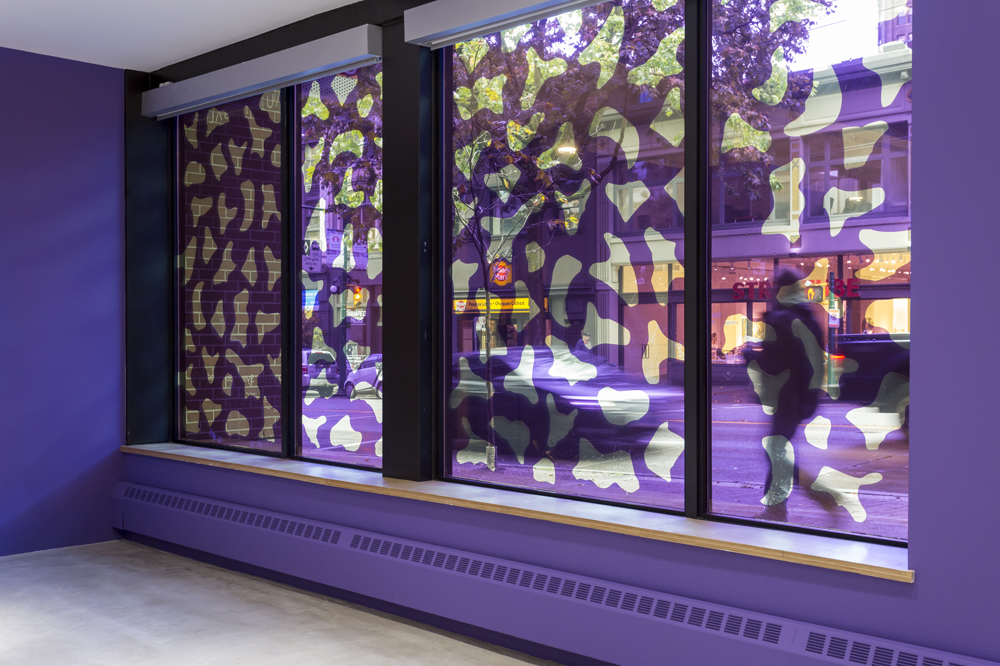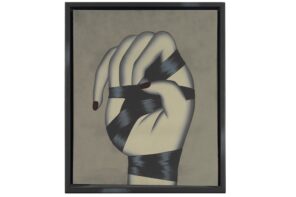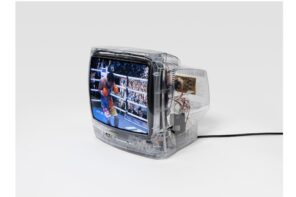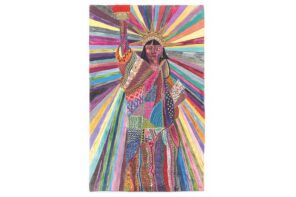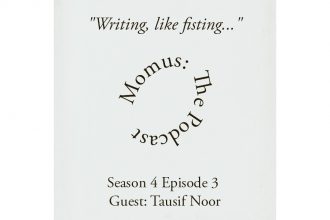Hair flicks, flirtatious glances, side eye. Hands beckoning and clapping, a finger wagging in rebuke. Body language is highlighted in Borrowed Lady, an exhibition that centers on Martine Syms’s recent video work, Notes on a Gesture (2015). This four-channel video features a black female actor performing a range of facial expressions (dejected, pleased, annoyed, disdainful) and hand gestures edited into brief loops on repeat (focused, at turns, on her hands or face). These visual tropes recall GIFs and emojis, crystallized communicators of mood. The videos play across small screens positioned at eye-level on stands arranged in a loose circle that viewers enter, turning from screen to screen. A loud, rhythmic soundtrack spills out of the Audain Gallery into the quiet of the surrounding university building. Its verbal content is often muffled, though the repeated phrase “Check yourself!” rings out clearly.
The L.A.-based Syms describes herself as “conceptual entrepreneur” rather than artist; in addition to creating installation, video, and performance works, she also writes, lectures, runs a small press – and previously directed a gallery space. Part of her “branding” is the recurring use of bright purple, which can be seen on her website and in her work. For Borrowed Lady, Syms paints the Audain Gallery’s walls in her trademark purple – which also echoes the purple backdrop behind the video’s performer. Additionally, a web-like pattern of enigmatic abstract forms in purple covers the gallery’s street-level windows. With her emphatic use of this color throughout the exhibition, Syms positions the work within an artistic lineage that includes such iconic African-American pop-cultural references as Prince’s Purple Rain (1984) and Alice Walker’s The Colour Purple (1982). Syms’s inventorying of black gesturality also channels the earlier auto-ethnographic tradition of Zora Neale Hurston, the anthropologist and author known for capturing a black vernacular in Their Eyes Were Watching God (1937) and collecting African-American folktales in Mules and Men (1935). While Hurston’s research focuses on the early twentieth century, Syms instead explores pop culture of the past few decades, including TV, movies, ads, and online media. Notes on a Gesture functions as a kind of anthropological archive or as a call-and-response tool for the teaching of specific forms of communication through mimicry. More importantly, it serves as an effective reminder of how popular media can influence and become part of a collective gesturing and vernacular – and vice versa.
In Agency and Embodiment (2009), scholar Carrie Noland argues that culture is embodied through a process she terms “corporeal performance.” In her discussion of how a body performs or moves differently depending on the social context, she asks, “How does individual human agency exert itself despite the enormous pressure of social conditioning?” This tension between individual agency and the socializing thrust of collective culture on the body is manifest in Notes on a Gesture, where the performer enacts an overarching gesturality of Black America at large. Although Syms’s subject primarily performs a lexicon of recognizable facial responses, occasional clips show her making more ambiguous expressions that hint at a personal range of expressivity beyond a conventional repertoire. The video’s recurring refrain to “Check yourself!” points toward the necessity for black men and women to be aware of how they move, speak, and carry themselves within the public arena, and to curtail themselves accordingly.
Thinking through Noland’s notions of performativity and agency in response to Notes on a Gesture elicits a myriad of questions. How is blackness articulated and constructed beyond skin tone? What gets communicated through specific movements and vocal inflections? How do instances of personal agency challenge collective corporeal performance? And what is the impact of this performativity on its subjects and viewers, and on culture at large as it’s recorded and diffused through various platforms?
In his essay “The New Cultural Politics of Difference” (1990), published in October almost three decades ago, philosopher and activist Cornel West discusses the impacts of ongoing “white supremacist assaults on Black intelligence, ability, beauty, and character” in conjunction with the longtime “problematic of invisibility and namelessness” faced by this group. West convincingly argues that the black diaspora has always focused on representation as a means of countering the damaging effects of this ongoing abuse as well as the invisibility of black people within the public sphere. One of the ways to resist this invisibility is articulated through the emergence of a range of black expressivity in the United States, as West details here:
… linguistic innovation in rhetorical practices, stylizations of the body as forms of occupying an alien social space (i.e., hairstyles, ways of walking, standing, talking, and hand expressions), means of constituting and sustaining camaraderie and community (i.e., antiphonal, call-and-response styles, rhythmic repetition, risk-ridden syncopation in spectacular modes in musical and rhetorical expressions) – were some of the strategies employed.
Martine Syms’s inventory of the facial movements of black female characters serves to identify aspects of the type of expressivity identified by West while underscoring its heightened performativity, which is rooted in the need to be seen. It also functions as a critique of conservative mainstream media which shows a limited range of types of characters (each with their own generic vocal and gestural tics), while it mocks, marginalizes, or misrepresents a wide spectrum of other voices and bodies – immigrant, queer, transgender, disabled persons; the list goes on. As Syms’s performer effortlessly flips from one facial expression to another, we are led to consider the dearth of roles available for black women, who are usually offered the stereotypical stock characters found in many a Hollywood drama or sitcom – like the sassy best friend and the no-nonsense matriarch – figures who lack complexity and agency, and are present merely as plot devices or to support the central (white) protagonist’s emotional arc.
Of course, in 1990, when West was writing his essay, there were no blogs, podcasts, or social media platforms like Facebook, Twitter, or Instagram, platforms that have played an important role in increasing black representation – and the control of this representation – within culture and politics. These shifts in digital media have been used by everyone from black activists and artists to counter both the abuse and the invisibility that West describes: from the use of the hashtag to create momentum and solidarity around the Black Lives Matter grassroots movement to the popularity of inexpensively made web series like The Mis-Adventures of Awkward Black Girl (2011-13), whose accomplished writer and principal actor Issa Rae would later be hired by HBO to develop the highly-polished TV show Insecure for its 2016 season.
Despite these advances, there continues to be a limited range of black humanity articulated in mainstream media. Even a fairly conventionally constructed show like Insecure thus comes across as radical in its depiction of the daily highs and lows of Issa, a complexly characterized middle-class black woman negotiating her relationships with her partner, friends, and colleagues in L.A. One way that Insecure really distinguishes itself in its portrayal of its heroine as fluent in speaking in a number of registers as she navigates various contexts – she talks one way with her mostly white coworkers, another way with her black partner and friends, and yet another way as an aspiring rapper. In vivid contrast, the recent film Moonlight (2016) explores the progressive muting of a black male’s verbal and physical expressivity at different stages of his life: as a neglected and bullied child, the protagonist Chiron is already rendered mostly silent; as a gay teenager, he tries to essentially erase himself from view by keeping his head down and avoiding eye contact; and as an adult with a criminal record who has experienced incarceration, he conceals his emotional vulnerability and sexuality under a mass of muscle.
Given Syms’s formal pastiche of the brevity and clipped pace of digital media (GIFS, memes, sound bites), Borrowed Lady is not favorable to a slower, more sustained contemplation of its ideas by the public. For this reason, it could have been useful for curator Amy Kazymerchyk to flesh out Syms’s reoccurring themes by including other works from her corpus within the exhibition, like S1:E1, an installation dedicated to black representation in sitcoms. Syms’s first Canadian exhibition is thus more a conversation starter than an opportunity for viewers to deeply delve into her practice as an artist, writer, and publisher.
Kazymerchyk has worked hard to expand the exhibition’s discursive scope by making available a selection of books and an annotated bibliography to the public as well as by organizing a series of public programs, including a screening of Syms’s videos and a conversation between the artist and Laura U. Marks (known for her book, The Skin of the Film: Intercultural Cinema, Embodiment, and the Senses). However, for a work of political resonance, Borrowed Lady is framed in conspicuously depoliticized terms with no explicit reference to questions around articulations of blackness in contemporary visual culture in the exhibition’s introductory text.
This use of apolitical language to discuss Syms’s examination of black corporeal performativity in Borrowed Lady defuses the political dimension of her project. As West points out in his still-pertinent essay, black vernacular expression has always had a spectacular, in-your-face quality – it’s about refusing to be ignored and insisting on being seen. With infectious panache, Syms channels a history of innovative, attention-grabbing ways of being, speaking, and moving, and mixes these traditions with contemporary modes of communication, thus revealing how these stylistic innovations continue to be articulated today.
The author thanks Antonio Loro for his feedback.












